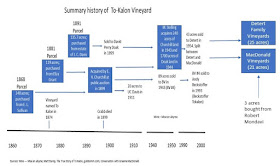 |
| Jujitsu training at an agricultural school in Japan circa 1920 (Source: wikipedia.com) |
I previously described the process whereby white wines are oxidized and the resulting effects. To summarize, the enzyme Tyrosinase (laccase in the case of botrytized must) catalyzes the formation of caftaric acid quinone, the result of the oxidation of the phenol caftaric acid. The quinone reacts with glutathione (a naturally occurring tripeptide found in grapes; and itself a powerful antioxidant) in the juice to form the colorless complex Grape Reduction Product (GRP). Once the glutathione is fully utilized, GRP is no longer formed and oxidation proceeds unencumbered (This process is called enzymatic oxidation. For a fuller description of this process, as well as the non-enzymatic oxidation of wine, see here.). The results of oxidation in white wines are browning, loss of fruity aromas, and gain of aldehydic aromas.
According to Jackson (Wine Science), "In contrast to red wines, the limited antioxidant character of white wines (ed: tannins and anthocyanins provide substantive antioxidant capability in red wines) make them more susceptible to oxidative browning." Further, grape varieties differ markedly in the amount of phenolics released during crushing or extracted during maceration (an extremely important consideration given that phenolics are the main substrate for oxidation activity). The table below shows the levels of flavonoid accumulation during crushing or maceration of selected white varieties.
Table 1. Phenolics released/extracted during crushing/maceration
| Variety | Flavonoid Accumulation |
| Palomino | Low |
| Sauvignon Blanc | Low |
| Riesling | Moderate |
| Semillon | Moderate |
| Chardonnay | Moderate |
| Muscat Gordo | Extensive |
| Colombard | Extensive |
| Trebbiano | Extensive |
| Pedro Ximinez | Extensive |
In the case of hyperoxidation, the deliberate introduction of oxygen into the juice causes enzymatic oxidation of the phenols. The process entails adding large amounts of oxygen to the juice, allowing it to settle, and then racking it from the brown precipitate just prior to fermentation. This oxidation will cause browning of the juice but the phenols will have been polymerized and will precipitate out.
Clarification is required to reduce the suspended solids to less than 1% by weight in order to remove the major part of the phenolic precipitate. This clarification must be completed before fermentation begins as the precipitate will re-dissolve in alcohol. The clarified juice will retain a brown color but this residual browning will be eliminated by the reducing conditions of alcoholic fermentation and absorption by yeasts (Schneider, Hyperoxidation: A Review, AJEV, 1998).
The brown pigment absorbed by the yeasts during alcoholic fermentation will fall to the bottom of the tank with the lees and can be removed in a post-fermentation racking. Fining and/or filtration can be utilized for additional clarification if required.This process renders the wine less susceptible to in-bottle browning (due to the elimination of the phenols) as well as reduces bitterness in the wine.
Hyperoxidation requires that SO2 additions be withheld from the must as the oxidative enzymes are inhibited in its presence. For example, tyrosinase registers a 90% decrease in activity when 50 mg/L of SO is added to the must. SO2 also reduces caftaric acid quinone and enhances the solubility of phenolic molecules. . These effects will limit the extent and effectiveness of the hyperoxidation. The implementation of hyperoxidation can thus allow for the production of low-sulfur wines.
Hyperoxidation, then, uses the strength of oxidation in the early stages of winemaking to neuter the substrate in the early stages of winemaking and prevent it from becoming an oxidation resource in the bottle. Jujitsu.
©Wine -- Mise en abyme































